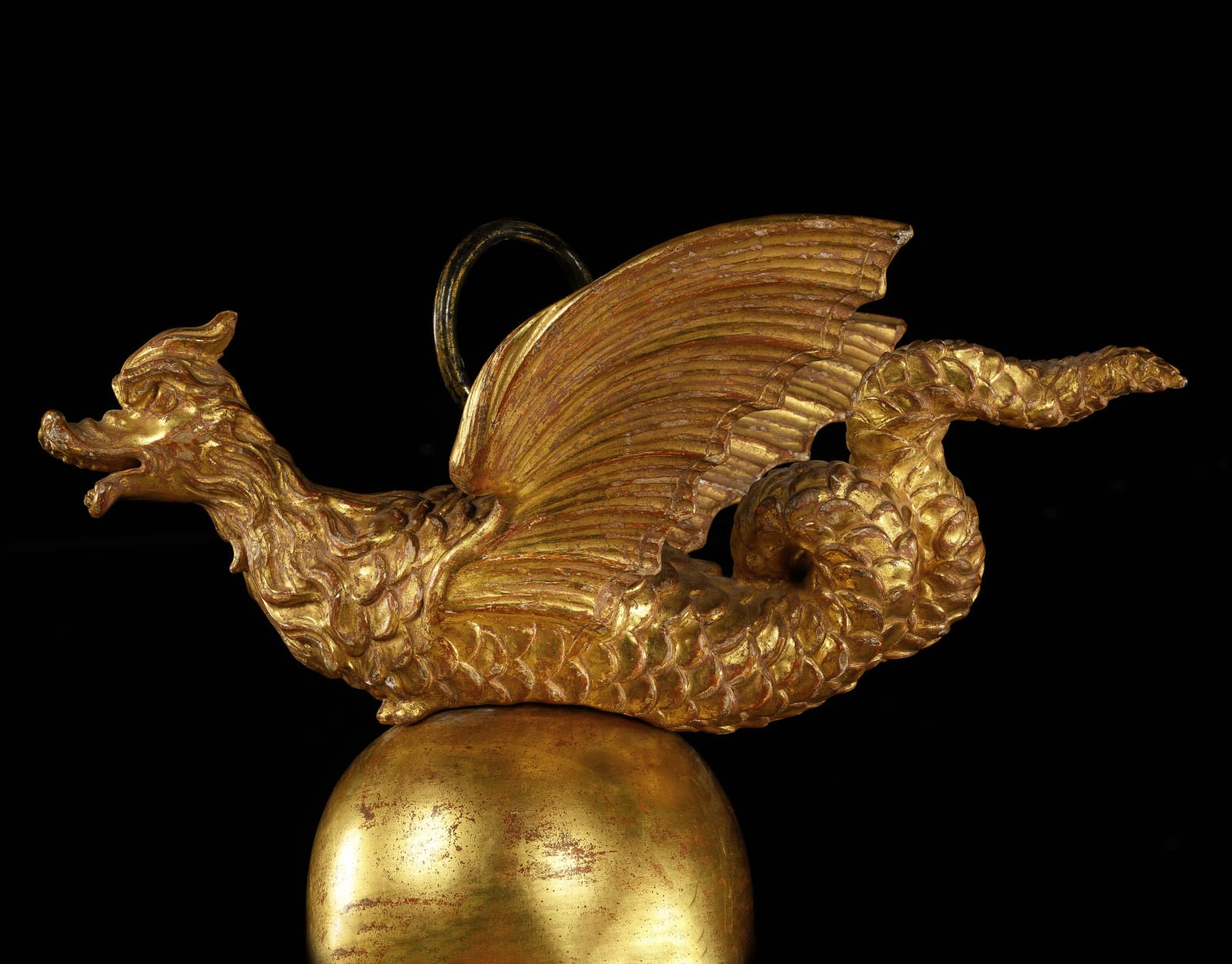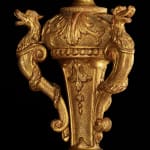A QUEEN ANNE GILTWOOD AND GILT-METAL CHANDELIER
Diameter: 91.5 cm
Further images
Provenance
Redburn Antiques, London, 1 April 1971 (inv. no. 27A)
The Collection of Doris Duke, Christie’s, New York, 15 April 2005, lot 145, USD 102,000
Ronald Phillips Ltd., London
Albany, An Important Private Collection, Sotheby's, London, 6 December 2023, lot 31, GBP 120,650
Literature
Desmond Fitzgerald, Georgian Furniture (London, 1969), no. 17
Victoria and Albert Museum, Fifty Masterpieces of Woodwork (London, 1955), No. 38
Hans Ottomeyer and Peter Pröschel, Vergoldete Bronzen: Die Bronzearbeiten des Spätbarock und Klassizismus (Munich, 1986), vol. I, p. 54, fig. 1.6.10
Publications
Ronald Phillips Ltd., Catalogue (London, 2006), p. 220
Surmounted by a wyvern upon a sphere on a baluster shaft carved with foliate scrolls on a hatched ground, with three scrolling wyvern volutes, the labrequinned and foliate carved support issuing scrolling foliate candle arms with gilt-brass eagle-cast drip pans and nozzles cast with lion masks and foliage with a fruiting foliate base.
English giltwood chandeliers of this period, quality, and condition are exceptionally rare.
The present example closely relates to a set of six originally supplied for the Queen’s Gallery at Kensington Palace, likely crafted by royal cabinet-makers James Moore and John Gumley. These chandeliers remained at the palace until the late 19th century. Subsequently, three were acquired by Sir Spencer Ponsonby-Fane for Brympton d’Evercy, Somerset, before being sold in 1956. One of these chandeliers is now housed in the Victoria and Albert Museum, London (W.28-1959) and remains on loan to Kensington Palace.
A further well-known pair, also attributed to Moore and Gumley, was supplied for the State Apartments at Holme Lacy, Herefordshire. One from this pair sold at Christie’s on 21 April 1995 (lot 243, $715,000) and now hangs in the Kirtlington Park dining room at the Metropolitan Museum of Art, New York (1995.141). Another exceptional giltwood chandelier, dated to circa 1740 and attributed to William Kent, is also in the V&A (416:1 to 10-1882). While more developed in Palladian form, it retains elements of the earlier Baroque design, such as an acorn finial, demonstrating a stylistic connection to the present example.2 A final related giltwood chandelier, attributed to James Moore, remains in the King’s Eating Room at Hampton Court Palace (RCIN 1018).
The design of this chandelier, and the small English group to which it belongs, draws inspiration from the rich arabesque forms of the Louis XIV and Régence periods. Hans Ottomeyer and Peter Pröschel illustrate numerous comparable French chandeliers in Vergoldete Bronzen, including a set of four by André-Charles Boulle in the Bibliothèque Mazarine, which closely relates to the present piece.3 Another Boulle gilt-bronze example is in the V&A (965-1882).
The influence of French craftsmanship in England can be attributed in part to figures such as Daniel Marot, a Huguenot designer and religious émigré, who introduced continental styles to London’s artisans. His Nouveau Livre d’Orfevrie Inventé par Marot, Architecte du Roy (1701–03) includes chandelier designs bearing a strong resemblance to the English group. Unlike their French counterparts, which were typically cast in gilt bronze, English chandeliers were crafted in giltwood, and fewer examples appear to have survived.
A distinctive feature of the present chandelier is the magnificent wyvern surmounting its structure—an unusual Baroque motif that may well have served as an heraldic device. Wyverns are associated with several noble families, the most notable being the Herberts. William Herbert, 2nd Marquess of Powis (1665–1745), incorporated a wyvern into the design of his London residence, Powis House,
and similar motifs appear in a pair of gilt-gesso mirrors offered at auction on 5 July 2023 (lot 14). Alternatively, Thomas Herbert, 8th Earl of Pembroke (1656–1733), a prominent statesman under Queen Anne and owner of Wilton House, may have commissioned the piece.
From the early 1970s until 2005, this chandelier was part of the collection of Doris Duke (1912–1993), the American heiress famously dubbed “the richest girl in the world” from birth. A philanthropist, adventurer, and discerning art collector, Duke assembled a remarkable collection, of which this chandelier was a prized possession.









